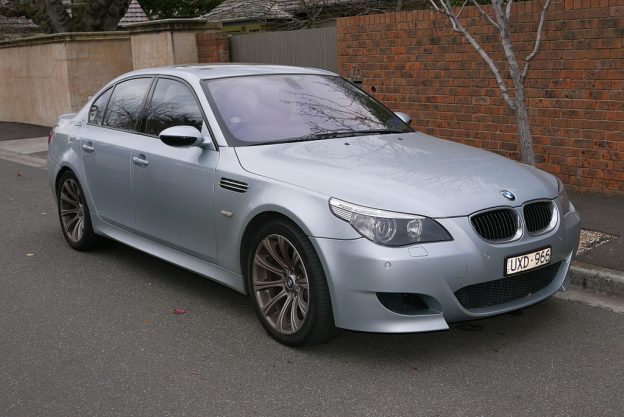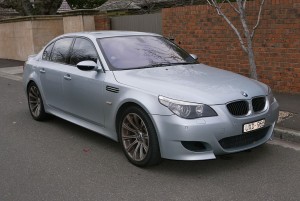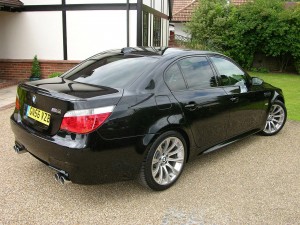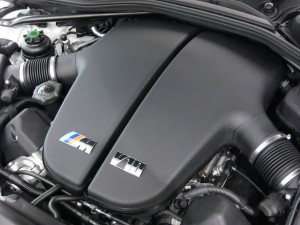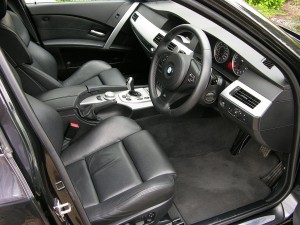BMW E60 M5: If Ferrari Built a Sedan
(E60 M5 – photo courtesy OSX)
The latest BMW M5 belts out 600 horsepower and a massive 553 lb-ft of torque from its twin-turbo 4.4-liter V-8. And yet, many BMW M aficionados still clamor for one of its most illustrious predecessors, the 2005-2010 version known by its model code, E60.
BMW M and Mercedes-AMG have been locked in a battle of performance supremacy for decades. Each new model ups the ante higher still. But to some enthusiasts, that doesn’t necessarily mean the absolute fastest car wins. The E60 version of the BMW M5 is a case in point. The E39 M5 that preceded the E60 packed a 400-horsepower punch from a 5-liter V8, blasting out a sound that mixed muscle car with road racer. Its successor, the 2006 M5, threw another 100 horses into the mix from a maniacal 5-liter V10 designed expressly for this car.
That number came with an asterisk. In “normal” mode, the V10 offered up the same 400 horses as its predecessor, certainly enough suds to tackle everyday driving. But then, at the push of the “M” button on the console, you unbridle the other 100 horses. Perhaps the idea was that you’d leave it in normal mode to restrain yourself.
(E60 M5 – photo courtesy The Car Spy)
Magnificently Evil Heart
A young car enthusiast peering under the hood of an E60 M5 might ask, “Where are the turbos?” Indeed, after driving one of today’s BMW M or Mercedes-AMG twin-turbo torque monsters, you might wonder why anyone would want a modern high-performance sedan without them.
(E60 M5 – S85 V10 Engine – photo courtesy Hatsukari715)
The BMW V10, known as the S85, can answer that in one drive. But be prepared to keep your right foot planted. Where today’s M5 puts down its max of 553 lb-ft of torque at a super-low 1,800 rpm, the E60 M5’s V10 doesn’t reach its much lower (but still substantial) 383 lb-ft peak torque until 6,100 rpm.
Fortunately, there are ample rewards for keeping your right foot down. The V10 screams to its 8,250-rpm redline in a way that recalls Ferraris and Lamborghinis. In fact, its engineering took at least some mechanical inspiration from the BMW-Williams Formula One V10. Of course, the F1 engine ultimately made 940 horsepower and revved to a stratospheric 19,000 rpm, so the parallels are slim.
Still, the M5 V10 was a screamer, thanks to a short-stroke design, 12:1 compression ratio and 10 individual, electronically actuated throttle valves. Car & Driver called it “the mother of all powertrains.” Using launch control, the magazine’s road testers recorded a blistering 4.2-second 0-60 time and the quarter-mile in 12.5 seconds at 118 mph. That’s still amazing today.
Top Gear’s Jeremy Clarkson was effusive in his praise for the E60 M5: “You just can’t believe you’re in a big 4-door saloon, because it goes and it feels and it SOUNDS like a Ferrari 430, and that’s about the best car I’ve ever driven.”
Evil Transmission?
Car & Driver’s acceleration times were achieved in an M5 equipped with BMW’s SMG 7-speed single-clutch transmission with manual and automatic modes. Slower and clunkier than the dual-clutch units used in some of today’s high-performance cars, it drew criticism. Fortunately, BMW listens to its M customers, and, wonder of wonders, the carmaker responded by offering a 6-speed manual transmission only for the U.S. and Canada! They’re somewhat rare, though. Of the 9,500 E60 M5s built for those markets, 1,364 had the stick shift.
More Than the Sum of Its Parts
(E60 M5 – photo courtesy The Car Spy)
The BMW E60 M5 was much more than a wild engine. The driver-selectable suspension lets you tailor the car for everyday driving or the racetrack. The uber-adjustable front seats keep you comfy for long drives, which, not surprisingly, will be interrupted by refueling stops. Having fun in an E60 M5 means guzzling premium-grade fuel at a rate not seen since the classic muscle car era.
It should not surprise anyone, either, to learn these M5s can be very expensive to repair. You should assume that most owners enjoyed these machines to their fullest, so research the E60 M5 thoroughly before committing. The rewards of finding and driving a good one will be memorable, indeed.
Why you’d want a BMW E60 M5:
Screaming 500-horsepower V10.
Last of the bareknuckle, naturally aspirated M cars.
No turbos means no turbo lag.
What a four-door Ferrari might be like.
